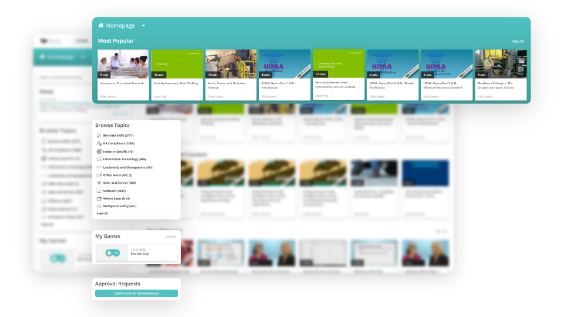EMPOWERMENT & DELEGATION TRAINING
FOR YOUR ORGANIZATION
FOR YOUR ORGANIZATION
Empowerment Versus Delegation
Delegation and empowerment are both useful and important managerial tools. Both techniques are used when managers are assigning work to their team. They each require a different mentality and expectation.When an employee is delegated a task, the manager often states what they want to be done, how they want it to be done, and decide on the timeframe to complete the task.
When an employee is empowered to do a task, they are the ones responsible for sharing the what, how, and when of the task. The employee is making their own decisions and taking ownership of the work.
Levels of Delegation
When it comes to delegation, there’s more to it than just telling someone, “Here, go do this.” Assigning the task is part of it, but with that comes responsibility and freedom to get the job done.There are six levels of freedom and responsibility in delegation:
- No authority. This is when a leader says, “Do the following, and then come back and tell me what happened.” It’s basic delegation. The leader simply offloads a task and micromanages the process. Employees have no discretion or value in what they do and are simply doing what they are told.
- Provide input. This is when a leader says, “Do the following, and come back with your thoughts.” Here, an employee is contributing their insights about the result. They’re now adding value but still aren’t allowed to have any input in the actual work.
- Seek approval.This is when a leader says, “Do the following, and check with me first if anything else comes up.” In this scenario, an employee is given a minimal amount of freedom to complete their work, they just must ask for permission first before veering of course.
- Keep informed. This is when a manager says, “Do the following, and keep me in the loop about what’s going on.” An employee now has some freedom to accomplish the task, but there is still a lack of full trust. Leaders are still keeping an eye and avoiding surprises, but from a distance.
- Exceptions only. This is when a manager says, “Do the following, and check with me if anything unusual comes up.” At this level, leaders no longer feel that they need to monitor the task. Employees are expected to handle the day-to-day requirements on their own and only report when something unexpected happens.
- Take care of it. This is when a manager says, “Do the following,” and the employee is left to their own devices. This is total delegation as leaders no longer have these tasks on their plate and trust the employee to use their own judgement, and thus begins empowering employees.
How to Use Delegation as an Empowerment Tool
Delegation refers to the transfer of responsibility for specific tasks from one person to another, and there are ways to make sure it is done effectively and will produce the best result.Know What to Delegate
It’s imperative to know that not every task can be delegated. For example, managers and leaders can’t delegate performance reviews. But there are tasks that require less oversight. Consider if there are tasks that an employee has skills in and assigning that task to them. This will show trust in employees and allow for time to focus on more big picture ideas.
Play to Employee Strengths
Every employee showcases strength and skills in a certain area, and those skills are usually tied to goals. Delegated work should factor into their professional goals. Leverage the talent present in a team, and employees will be more motivated and engaged.
Offer Guidance
When assigning tasks, offer employees guidance and any necessary training to get the job done. When employees understand the why of their work, they will be able to innovate and come up with creative solutions to problems that arise. And, if (and when) they fail, be there to offer some course correction and constructive feedback.
Provide Resources and Alleviate Barrier
Don't assume employees have the knowledge and access to get what they need. Leaders can anticipate needs and acquire what's necessary. There will be speedbumps and roadblocks along the way – organizational processes, conflicts, etc. – so be ready to help them with the politics or challenges that arise.
Allow for Failure
This is an important step in delegation. There’s often not just one wat to get things done, so allow employees to use experimentation and find a new approach. Being open to new ideas will make delegating in the future easier because trust has been built on the team.
Offer Acknowledgement and Recognize Effort
Stay up to date with team efforts, show recognition for a job well done, and celebrate success and met milestones.
Preview Videos from The BizLibrary Collection
Leadership Toolkit: Empowerment

Leadership Toolkit: Delegation

Leadership and Delegation (Part 4 of 6): Delegating Authority

The Importance of Employee Empowerment
Employee empowerment is a philosophy that emphasizes the importance of employees being able to make their own, independent decisions and then act on them. On top of that, it means that trust and understanding has been developed on a team and/or between a manager and employee.
Motivation
When employees feel autonomous in their roles, they are more motivated to do their jobs. When given control to decide where, when, and how they do their work team members can be more productivitive and engaged. Employees that are engaged and motivated feel more satisfied at the end of the day.
Increased Trust in Leadership
By empowering employees, leaders are more likely to be trusted by their subordinates. This is for leaders who empower their employees by acting as coaches, helping their employees do their best work, and offering support when needed. Empowered employees feel like leaders won’t take advantage of them but instead celebrate their achievements.
Boosted Creativity
Empowering leaders have direct reports that are seen as more creative. Allowing employees to think for themselves and collaborate across teams generates more creative ideas. Highly-empowered employees are likely to be more engaged in the organization and could take on more assignments or join extracurricular endeavors.
Why Online Training Works for Learning Empowerment and Delegation
Being a leader that knows how to delegate but also empower employees is crucial to keeping employees productive and engaged.
BizLibrary curates a large and diverse video training library with numerous courses focused on empowerment and delegation.

Explore more
of our leadership
skills topics.
Online training is quickly becoming the best way to teach employees some of the skills they need to do their jobs. Numerous studies have shown that online training is often more effective, and learners retain more information than with classroom training alone.
Our micro video format breaks content up into smaller, more manageable chunks, making it easier for employees to learn and apply these skills on the job. These online courses can be viewed on an individual basis – where an employee learns by themselves at work or at home – or as part of a group training environment or discussion.
Help your leaders and managers learn to empower their team members to get things done effectively. Talk with an expert to learn how our online learning solutions can transform training in your organization.
